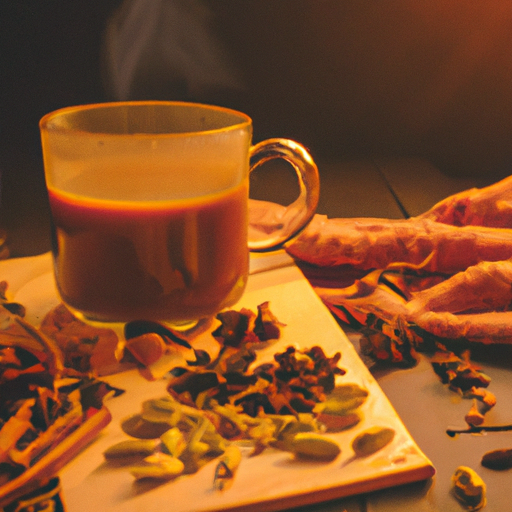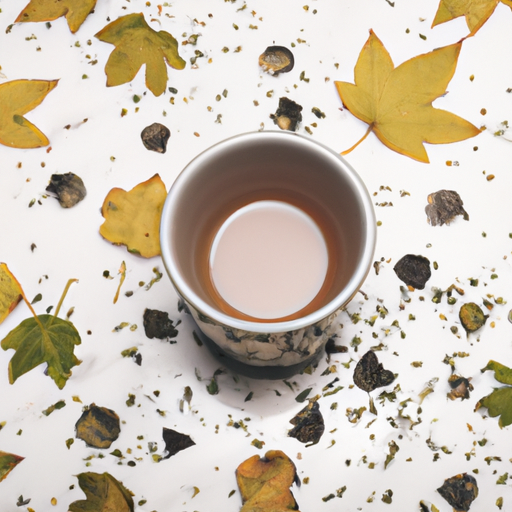I’m totally enamored with chai tea, particularly when it’s served cold! The mix of spices and sugary taste really satisfies especially during the warmth of a sunny day.
And while I used to think that making my own iced chai at home would be too complicated, I’ve learned that it’s actually quite simple with the right ingredients and tools.
In this article, I’ll share with you my step-by-step process for making delicious iced chai tea in your own kitchen. From brewing the perfect tea to customizing it to your liking, I’ll cover everything you need to know to create a refreshing and satisfying drink that will impress even your most discerning guests.
So let’s get started!
Key Takeaways
- Iced chai tea can be made using different types of tea leaves and spices, as well as milk or dairy substitutes for a creamier texture.
- There are various brewing techniques for making iced chai, such as hot brew, cold brew, sun tea, and instant pot method.
- Chai tea offers health benefits like boosting digestion and immunity, reducing inflammation, and adding protein and calcium to the diet.
- Chai tea has a rich history and cultural significance in many countries, with unique spice blends that give each version a distinct flavor profile.
Gather Your Ingredients and Supplies
Now let’s grab all the ingredients and supplies we’ll need to make this delicious iced chai! To start, make sure you have some tea accessories on hand, such as a teapot, strainer, and tea infuser. These will come in handy when brewing the tea.
Next, it’s important to choose the best chai tea brands for your recipe. Some popular options include Tazo Chai Tea or David Rio Elephant Vanilla Chai Tea. You could also try making your own blend using loose leaf black tea and spices like cinnamon, ginger, cardamom, cloves, and nutmeg.
Aside from the key ingredients, you’ll also need some basic kitchen equipment like a saucepan or kettle to heat up the water and a pitcher to store your finished iced chai in.
Once you’ve gathered everything together, it’s time to move onto the next step: brew your tea…
Brew Your Tea
First, steep your favorite blend of tea in hot water until it reaches the desired strength. This is a crucial step in making the perfect iced chai tea at home. There are different types of tea leaves you can use to make iced chai, such as black tea, green tea, or even herbal blends. The brewing time and temperature will vary depending on the type of tea you choose.
Here are some popular tea brewing techniques for making iced chai:
-
Hot brew: Steep your preferred type of tea in hot water for 3-5 minutes, then remove the teabag or strain loose leaves.
-
Cold brew: Place loose leaf or teabags in cold water and refrigerate overnight for a smooth and mellow flavor.
-
Sun Tea: Fill a glass jar with cold water and add teabags or loose leaf teas. Leave it outside to infuse under direct sunlight for several hours.
-
Instant Pot method: Add water and teabags or loose leaf teas to an instant pot pressure cooker and set it on high pressure for a few minutes.
When choosing your type of tea leaves for iced chai, consider using black teas like Darjeeling or Assam, which have robust flavors that complement spices like cinnamon and cardamom commonly used in chai recipes.
Now that you’ve brewed your perfect cup of tea, it’s time to move onto the next step – blending your iced chai with milk and spices to create that classic Indian-inspired taste sensation!
Blend Your Iced Chai
Get ready to experience a deliciously blended cup of iced chai by adding milk and spices to your freshly brewed tea! Blending techniques play an essential role in achieving the perfect consistency and flavor.
To make a creamy, smooth blend, add about half a cup of whole milk or almond milk for a nuttier taste. You can also use soy or oat milk if you prefer plant-based options.
Next, it’s time to spice things up! Add your favorite spices like cinnamon, ginger, cardamom, nutmeg, and cloves. You can customize the amount of each spice based on your preference and taste. For example, if you like stronger ginger notes in your drink, add more ginger powder or fresh ginger slices into the mix. The key is to experiment with different spice combinations until you find the perfect balance that satisfies your cravings.
Blending the iced chai mixture will help infuse all the flavors together. Use a blender or shaker bottle to combine all ingredients thoroughly.
Once done, pour over ice and enjoy! Customize your iced chai by adding whipped cream on top or drizzling caramel sauce for extra sweetness. With endless flavor variations available at home, there’s no need to hit up coffee shops for an expensive cup of iced chai anymore!
Customize Your Iced Chai
Now that I’ve got my iced chai, it’s time to customize it to my liking.
First off, I like my drinks on the less sweet side, so I’ll adjust the sweetness level by adding less sugar or honey.
Next, I’ll add in some milk or dairy substitute such as almond milk for a creamier texture.
Lastly, to give my drink an extra kick of flavor and presentation, I’ll garnish it with some cinnamon or nutmeg spice on top.
Adjust Sweetness
If you find the chai tea too sweet, you can easily adjust the sweetness by adding less honey or sugar. For example, my friend Sarah prefers a less sweet drink and she adds only half a teaspoon of honey to her iced chai tea, which makes it perfect for her taste buds.
Here are some tips to help you adjust sweetness and create your desired flavor variations:
- Use agave nectar instead of honey or sugar for a more subtle sweetness.
- Add spices like ginger or nutmeg for a spicy kick that balances out the sweetness.
- Experiment with different types of milk or dairy substitutes to see how they affect the overall sweetness and flavor profile.
Now that we’ve adjusted our sweetness, let’s move on to adding milk or dairy substitute to our iced chai tea.
Add Milk or Dairy Substitute
To achieve a richer and creamier texture, it’s recommended to include a milk or dairy substitute when preparing your chai beverage. You can choose from a variety of options such as whole milk, almond milk, coconut milk, soy milk or oat milk. If you prefer a dairy-free option, then almond or coconut milk could be the perfect choice for you.
Adding milk not only improves the taste but also brings nutritional benefits to your beverage. Milk is an excellent source of calcium and protein that can help maintain healthy bones and muscles. Dairy substitutes like almond or coconut provide essential vitamins and minerals while being low in calories and saturated fats.
Once you’ve added your preferred amount of dairy or non-dairy substitute to your iced chai tea, it’s time to move onto the next step – garnishing with spices!
Garnish with Spices
Spice up your beverage by sprinkling cinnamon, nutmeg, or cardamom on top of your frothy milk or dairy substitute. These spices not only add flavor but also create an aesthetically pleasing presentation to your drink.
Here are three spice blend options and creative garnish ideas that will take your iced chai tea to the next level:
-
Cinnamon sugar: Mix equal parts cinnamon and granulated sugar together and sprinkle it over the foam of the milk or dairy substitute for a sweet and spicy kick.
-
Nutmeg and vanilla bean: Grate fresh nutmeg over the top of the milk foam, then add a small piece of vanilla bean for a subtle sweetness.
-
Cardamom pods: Crush cardamom pods with a mortar and pestle, then sprinkle them over the top of the milk foam for an exotic touch.
Now that you’ve added the perfect garnish to your iced chai tea, let’s move on to some tips for perfecting your drink even more!
Tips for Perfecting Your Iced Chai
You’ll want to pay attention to the strength of your tea when perfecting your iced chai. Depending on your spice preferences, you may need a stronger or weaker brew. It’s also worth noting that there are many variations of chai tea, ranging from traditional Indian recipes to more modern blends that incorporate different spices and flavors.
To get the perfect iced chai, start with a strong black tea base. You can use loose leaf tea or tea bags, but be sure to steep it for at least five minutes. Next, add in your preferred spices. Cinnamon, cardamom, ginger, and cloves are all common ingredients in chai tea blends. Experiment with different ratios until you find the combination that suits your taste buds.
Don’t forget about the sweetener and milk! Chai is traditionally served sweetened and with milk or cream added in. However, feel free to adjust the sweetness level and type of milk used based on personal preference.
Once you’ve perfected your recipe, sit back and enjoy all of the health benefits that come with drinking chai tea regularly. Incorporating chai into your daily routine can help boost digestion and immunity while reducing inflammation throughout the body. So go ahead – indulge in this delicious beverage knowing that it’s doing wonders for both your taste buds and overall well-being!
Health Benefits of Chai Tea
Did you know that incorporating chai into your daily routine can provide numerous health benefits, such as boosting digestion and immunity while reducing inflammation throughout the body? Here are three ways that chai tea can be good for your health:
-
Chai tea contains a variety of spices, including ginger and cinnamon, which have been shown to aid in digestion by increasing the production of digestive enzymes. This can help alleviate symptoms such as bloating, gas, and constipation.
-
The black tea used in chai also contains antioxidants called catechins, which may help reduce inflammation in the body. Inflammation has been linked to various chronic diseases like heart disease and arthritis, so incorporating chai into your diet could potentially be beneficial for overall health.
-
Chai tea recipe variations often include milk or non-dairy alternatives like almond milk, which can add protein and calcium to your diet. These nutrients are essential for maintaining strong bones and muscles.
If you’re looking for a tasty way to improve your health, consider adding chai tea to your daily routine! Not only does it taste great, but it also provides numerous health benefits.
Next up: serving suggestions for enjoying iced chai at home!
Serving Suggestions
Get ready to elevate your chai game with these creative serving suggestions that’ll take your enjoyment of this delicious beverage to the next level!
One way to add a unique twist to your iced chai is by experimenting with different flavor combinations. For example, you could add a splash of vanilla extract or almond milk for a creamier taste. Alternatively, try adding a sprinkle of cinnamon or nutmeg on top for an extra kick.
Another aspect to consider when serving your iced chai is the vessel you use. While traditional glassware is always an option, why not mix it up and serve your chai in a mason jar or even a small flower vase? These unconventional options will make for great conversation starters at any gathering.
Now that you’ve got some ideas for how to serve up your iced chai, it’s time to move onto the logistics of storing and reheating this flavorful beverage without diminishing its quality.
Storing and Reheating Your Iced Chai
So you’ve made a delicious batch of iced chai tea at home, but what do you do with the leftovers? As someone who enjoys iced chai regularly, I know that refrigeration and reheating can affect the taste and texture of the drink.
In this discussion, I’ll share some tips on how to properly store and reheat your iced chai to ensure it stays fresh and flavorful.
Refrigeration
After steeping the chai tea bags in boiling water, let it cool down before refrigerating it overnight for a stronger flavor. For example, I once left my iced chai in the fridge for two days and the spices had infused so well that it tasted like heaven. Refrigeration is not only important for taste but also for safety reasons – keeping your beverage at a cold temperature will prevent bacteria growth.
When refrigerating your iced chai, make sure to choose the right container as well. A glass pitcher or mason jar works great and allows you to see how much is left without having to open it up frequently, which can cause temperature fluctuations. Benefits of refrigeration include an extended shelf life of up to four days and ensuring that your drink stays fresh and flavorful. With all these benefits, why not give refrigerating a try?
Now onto freezing – if you want to prolong the shelf life even more or make a large batch ahead of time, freezing is a great option.
Freezing
If you’re looking to keep your spiced tea fresh for longer periods or want to enjoy it during off seasons, freezing is a fantastic alternative.
Before putting the chai tea in the freezer, make sure that it’s cooled down completely. Pour the tea into an airtight container and leave some space at the top as the liquid will expand when frozen. Alternatively, you can pour it into ice cube trays and freeze them separately. This way, you can easily take out one or two cubes whenever you crave for iced chai.
When reheating frozen chai tea, avoid microwaving it directly as this may alter its flavor profile. Instead, thaw the container first by leaving it in the fridge overnight or running warm water over it until it’s soft enough to transfer into a pot on medium heat.
Add milk and sweetener according to your preference and let it simmer for a few minutes before serving. Preparation techniques and flavor variations are endless with iced chai tea – experiment with different spices like nutmeg or cardamom to create your own signature blend!
Reheating
To enjoy your leftover spiced tea, you’ll want to reheat it just right, bringing back the warm and comforting flavors that you remember. Reheating is a simple process but requires some attention to detail.
Here are five tips to consider when reheating your iced chai tea:
- Use a microwave-safe container if reheating in the microwave.
- To prevent overheating and changing the taste of the tea, use low power settings or defrost mode.
- If using a stovetop, heat slowly on medium-low heat while stirring occasionally.
- The ideal temperature for reheating iced chai tea is between 145°F and 155°F (62°C -68°C).
- Avoid boiling or overheating the tea as it can cause bitterness.
Reheated iced chai tea tastes best when done correctly, so take your time and enjoy every sip.
Now that we know how to reheat our iced chai tea, let’s explore how this delicious beverage is enjoyed around the world.
Chai Tea Around the World
Explore the diverse flavors of chai tea from around the world, and add a new twist to your iced chai recipe.
Chai tea has a rich history and cultural significance in many countries, and each region has its own unique blend of spices that give their chai tea a distinct flavor profile.
In India, for example, chai tea is typically made with black tea leaves, milk, sugar, and a combination of spices such as cinnamon, cardamom, ginger, and cloves.
In Pakistan and Afghanistan, they have their own version of chai tea called ‘qahwa,’ which is made with green tea leaves instead of black.
Qahwa also includes saffron and almonds in addition to the traditional chai spices.
In Morocco, mint is added to their version of chai tea known as ‘nana’ or ‘nane.’ This gives it a refreshing taste that’s perfect for hot summer days.
If you’re feeling adventurous with your iced chai recipe at home, why not add some international flair by trying out these different versions?
You can experiment with different types of teas like green or white teas instead of black for a lighter flavor.
And don’t be afraid to play around with different spice combinations too! Whether you prefer your iced chai spicy or sweet or somewhere in between – there’s no wrong way to enjoy this delicious beverage.
Frequently Asked Questions
What is the difference between chai tea and regular tea?
When it comes to comparing chai tea with regular tea, there are a few differences that set them apart.
Chai tea originated in India and is made by steeping black tea leaves with a mixture of spices like cinnamon, cardamom, ginger, cloves and pepper. The combination of these spices gives chai its unique flavor profile which can be described as spicy, sweet, and aromatic.
On the other hand, regular tea is typically made from just tea leaves without any added spices or flavors. Additionally, chai is often consumed with milk and sugar while regular tea can be enjoyed plain or with a splash of milk or honey.
Overall, the differences in ingredients and preparation give each type of tea its own distinct taste and character.
Can I use a different type of tea besides black tea for my iced chai?
Yes, you can definitely use different types of tea besides black tea for your iced chai. There are many alternative teas that can be used to create a unique and flavorful twist on the traditional recipe. For example, green tea or white tea can be used to create a lighter version of chai with a more subtle flavor profile.
Rooibos or herbal teas can also be used for a caffeine-free option with added health benefits. Additionally, there are many flavor variations for chai such as adding spices like cardamom, cinnamon, or ginger to enhance the taste. Experimenting with different types of tea and spices can lead to endless possibilities for creating your own delicious and personalized version of iced chai at home.
How can I adjust the sweetness level of my iced chai?
Adjusting the sweetness in iced chai is easy – just add more or less sweetener to the recipe. There are many variations of the classic chai tea recipe, so it’s important to experiment with different flavors and spices until you find your perfect blend.
Some people prefer a sweeter drink, while others enjoy a more spicy flavor profile. To achieve this, I like using honey or maple syrup as my sweetener of choice since they add a natural sweetness and depth of flavor to the tea.
You can always adjust the amount of sweetener you add based on your personal taste preferences. Don’t be afraid to get creative with your flavor variations by adding additional ingredients like vanilla extract or cardamom pods for an extra kick!
Can I use a plant-based milk substitute for my iced chai?
When it comes to creating the perfect iced chai, using a plant-based milk substitute is definitely an option.
There are so many different flavor options available that can really enhance the overall taste of your drink.
Personally, I like to use almond milk because it has a slightly nutty and sweet flavor that pairs well with the spices in chai tea.
However, you could also try using coconut milk for a creamier texture or soy milk for a more neutral taste.
The key is to experiment and find what works best for you.
Just keep in mind that some plant-based milks may alter the flavor of your chai slightly, so be sure to adjust any additional sweeteners or spices accordingly.
How long can I store my leftover iced chai in the refrigerator?
I usually store my leftover iced chai in the refrigerator for up to two days. After that, the flavor can start to deteriorate and it may not taste as good. To ensure that your iced chai stays fresh, you should keep it in an airtight container.
If you want to switch up the flavor of your leftover iced chai, you can try adding different spices or sweeteners. For example, I like to add a little bit of vanilla extract or honey to my iced chai for some extra sweetness. You could also experiment with using different types of milk or milk substitutes to change the flavor profile of your drink.
Overall, storing your leftover iced chai properly and playing around with flavor variations can help you enjoy this delicious beverage even more!
Conclusion
Well, there you have it, folks. Making iced chai tea at home is super easy and delicious! With just a few simple ingredients and supplies, you can whip up a refreshing beverage that will quench your thirst on hot summer days.
It’s like having your own personal oasis of flavor in a glass – sweet yet spicy notes that dance on your tongue with every sip. Plus, the health benefits of chai tea are nothing to scoff at either!
From aiding in digestion to reducing inflammation, this drink packs a punch both in taste and wellness.
So what are you waiting for? Grab some tea bags and spices and get brewing! Your taste buds (and body) will thank you for it.










